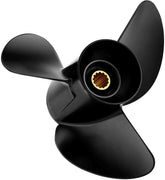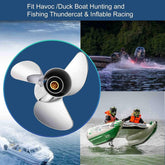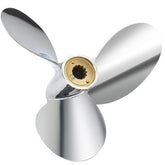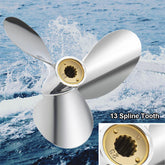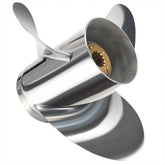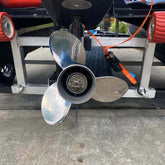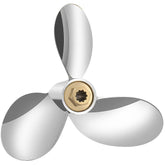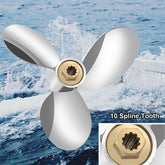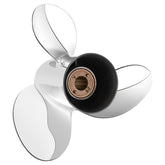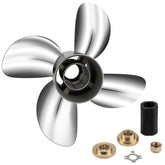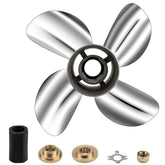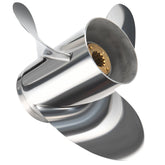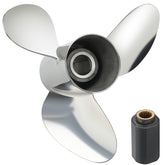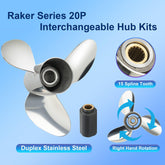Aluminum Propellers for 115-250HP Tohasu Outboard Boat Motor
When you’re outfitting a Tohasu outboard boat motor—any model from 115HP up to 250HP—you need a propeller that fits precisely, performs reliably, and won’t break the bank. We produce a comprehensive line of aluminum propellers engineered specifically to match the gearcase and spline configuration of 115-250HP Tohasu motors, making them fully compatible with many Yamaha and Mercury applications from model year 2014 onward. While we are not the official OEM for Yamaha, Mercury, Suzuki, Volvo, or Honda, our aftermarket propellers meet or exceed industry standards, delivering excellent thrust, efficient fuel economy, and an extended service life.
Below, you’ll find a detailed overview of every propeller in our 15-spline, 4¾″ gearcase series: blade count, diameter, pitch, rotation, and OEM cross-references (where applicable). We’ve organized the data into two main categories—3-blade and 4-blade propellers—so you can quickly identify which configuration best suits your boat’s hull and performance requirements.
Why Choose Our Aluminum Propellers?
-
Precision Casting & Balanced Finish
Each propeller is cast from high-grade aluminum alloy, then CNC-machined and dynamically balanced. You’ll notice smoother acceleration and reduced vibration, even at wide-open throttle. -
Cost-Effective Performance
Instead of paying high OEM prices, our after-market propellers typically cost 40–50% less than a Yamaha or Mercury part. You save money without sacrificing durability or reliability. -
Compatibility & Drop-In Fitment
These props fit 115-250HP Tohasu outboard lower units (gearcase size: 4¾″, spline: 15). They also interchange with the same-year Yamaha BFT115–BFT250 and Mercury Verado/Mercury FourStroke models, as long as the spline count and gearcase dimensions match. -
Wide Selection of Diameters & Pitches
From tight, low-pitch blades designed for quick planing on heavily loaded boats, to higher-pitch styles optimized for top-end speed on lightweight hulls—we have you covered. -
Multiple Rotation Options
Whether you run a single right-hand (clockwise) prop or a twin-engine setup requiring matched left-hand/ right-hand pairs, we provide both rotation directions on select part numbers. -
Reliable After-Sales Support
With North American warehouses in the USA and Canada, we can often ship same-day, minimizing downtime. Every purchase includes a 30-day return policy to ensure you’re completely satisfied.
Key Specifications & Table Layout
All propellers listed below share the following attributes:
-
Spline Count: 15 teeth
-
Gearcase Size: 4¾″ (4.75 inches)
-
Applicable Motor HP: 115HP – 250HP Tohasu (model year 2014 & newer)
-
Material: High-strength aluminum alloy (6061-T6 or equivalent)
-
Finish: Precision machined, polished tips, clear coat for corrosion resistance
Our table columns are defined as follows:
-
OEM Number: If your boat builder or engine manufacturer published an OEM cross-reference, you’ll see it here. Otherwise, this field may be blank.
-
Part Number: Our internal part code. Use this when ordering to ensure you receive the exact diameter, pitch, blade count, and rotation you need.
-
Blades (B): Number of blades—either 3 or 4.
-
Diameter (D): Overall span of the blade circle, measured in inches (″).
-
Pitch (P): Theoretical distance (in inches) the propeller would travel in one full rotation through a solid medium—higher pitch = greater top‐end speed, but requires more torque to spin.
-
Rotation (R): “R” indicates right-hand (clockwise from behind), and “L” indicates left-hand (counterclockwise from behind).
3-Blade Aluminum Propellers
3-blade propellers generally provide an excellent balance between acceleration (hole-shot) and top-speed performance. They remain the most popular choice for solo-engine installations on bass boats, runabouts, and small cruisers. Use the table below to identify part numbers with or without OEM cross-references:
| OEM Number | Part Number | B | Diameter (D) | Pitch (P) | Rotation (R) |
|---|---|---|---|---|---|
| — | 1001-140-23 | 3 | 14″ | 23″ | R |
| — | 1001-141-21 | 3 | 14¼″ | 21″ | R |
| — | 1001-142-19 | 3 | 14½″ | 19″ | R |
| — | 1001-148-17-R | 3 | 14⅘″ | 17″ | R |
| — | 1001-148-17-L | 3 | 14⅘″ | 17″ | L |
| — | 1001-150-15 | 3 | 15″ | 15″ | R |
| — | 1001-150-17 | 3 | 15″ | 17″ | R |
| — | 1001-151-15 | 3 | 15¼″ | 15″ | R |
| — | 1001-151-19-R | 3 | 15¼″ | 19″ | R |
| — | 1001-151-19-L | 3 | 15¼″ | 19″ | L |
| — | 1001-151-20-R | 3 | 15¼″ | 20″ | R |
| — | 1001-151-20-L | 3 | 15¼″ | 20″ | L |
| — | 1001-151-21-R | 3 | 15¼″ | 21″ | R |
| — | 1001-151-21-L | 3 | 15¼″ | 21″ | L |
| — | 1001-151-23-R | 3 | 15¼″ | 23″ | R |
| — | 1001-151-23-L | 3 | 15¼″ | 23″ | L |
| — | 1001-152-17-R | 3 | 15½″ | 17″ | R |
| — | 1001-152-17-L | 3 | 15½″ | 17″ | L |
| — | 1001-153-15-R | 3 | 15¾″ | 15″ | R |
| — | 1001-153-15-L | 3 | 15¾″ | 15″ | L |
| — | 1001-160-11 | 3 | 16″ | 11″ | R |
| 1511-160-13 | 1001-160-13 | 3 | 16″ | 13″ | R |
| 9511-155-17 | 1001-160-17 | 3 | 16″ | 17″ | R |
| 9511-153-19 | 1001-160-18.5 | 3 | 16″ | 18½″ | R |
| — | 1001-160-20 | 3 | 16″ | 20″ | R |
| — | 1001-160-21.5 | 3 | 16″ | 21½″ | R |
Table Notes:
Any entry with “—” under OEM Number indicates there is no direct OEM cross-reference provided by Yamaha, Mercury, etc.
Part Numbers (1001-XXXX) represent our in-house catalog codes.
Left-hand (“L”) rotations are only necessary for twin-engine installations where you want counter-rotation on the port side.
How to Read the 3-Blade Table
-
Blade Count (B = 3):
All entries above have three blades, which translates into a balanced combination of hole-shot acceleration and respectable top-end speed. -
Diameter (D):
-
Ranges from 14″ to 16″.
-
Choose a smaller diameter (14″–15″) for lighter boats or applications where you need high RPM and maximum top speed.
-
Opt for larger diameters (15½″–16″) if you run heavier loads or carry more passengers—this yields stronger thrust at lower RPM.
-
-
Pitch (P):
-
Low-pitch models (11″–15″): Excellent for quick planing, especially on boats that struggle to get on plane.
-
Mid-pitch models (17″–19″): Offer a compromise for mixed use—smoother acceleration and comfortable cruising RPM.
-
High-pitch models (21″–23″): Ideal for high-speed, lightweight hulls that need to hit WOT RPM (wide-open throttle) efficiently.
-
-
Rotation (R/L):
-
R (Right-hand): Standard rotation for most applications—prop turns clockwise when viewed from behind.
-
L (Left-hand): Counter-rotation—used exclusively on the port side of twin-engine setups to minimize torque steer and improve tracking.
-
4-Blade Aluminum Propellers
By adding a fourth blade, you increase the propeller’s “bite” in the water, which translates into quicker hole-shots, improved low-end thrust, and better handling in chop or rough seas. Four-blade props tend to run at slightly lower top-end RPM but deliver a rock-steady ride under load.
| OEM Number | Part Number | B | Diameter (D) | Pitch (P) | Rotation (R) |
|---|---|---|---|---|---|
| — | 1002-140-17 | 4 | 14″ | 17″ | R |
| — | 1002-140-19 | 4 | 14″ | 19″ | R |
| 1513-140-21 | 1002-140-21 | 4 | 14″ | 21″ | R |
| 1513-143-19 | 1002-141-19 | 4 | 14¼″ | 19″ | R |
| — | 1002-142-13 | 4 | 14½″ | 13″ | R |
| — | 1002-142-15 | 4 | 14½″ | 15″ | R |
| 1513-145-17 | 1002-142-17 | 4 | 14½″ | 17″ | R |
| — | 1002-150-13 | 4 | 15″ | 13″ | R |
| — | 1002-150-15 | 4 | 15″ | 15″ | R |
Table Notes:
As with the 3-blade series, any “—” under OEM Number indicates no direct factory cross-reference.
Part Numbers (1002-XXXX) are our in-house codes.
All 4-blade propellers are Right-hand (“R”) rotation. Left-hand versions are uncommon for 4-blades in our lineup.
How to Read the 4-Blade Table
-
Blade Count (B = 4):
Four blades add extra surface area, which pushes more water per revolution. You’ll notice improved hole-shot (getting up on plane), reduced slippage under load, and better low-end performance—especially on heavily loaded or planing-challenged hulls. -
Diameter (D):
-
Available in 14″, 14¼″, 14½″ and 15″ sizes.
-
Smaller diameters provide a higher rev ceiling, while larger diameters deliver more bite and thrust.
-
-
Pitch (P):
-
13″–15″ Pitches: Great for heavy loads, fishing boats, or pontoon boats where initial thrust matters most.
-
17″–21″ Pitches: Offer a balance—decent acceleration plus a respectable cruising speed.
-
-
Rotation (R):
All entries above are Right-hand (“R”) rotation. If you need a left-handed 4-blade, please ask our sales team about custom or special-order availability.
Selecting the Right Propeller: Detailed Insights
Choosing a propeller isn’t just a matter of picking numbers off a table. It requires taking into account your boat’s weight, hull shape, expected load, cruising habits, and desired RPM band. Below are in-depth considerations to guide your decision:
-
Hull Type & Weight Distribution
-
Lightweight V-hulls (e.g., fiberglass bass boats or sleek runabouts):
-
Aim for a smaller diameter (14″–15″) and mid- to high-pitch (17″–23″) 3-blade propeller. This combination helps you hit WOT RPM faster and gives crisp acceleration as soon as you punch the throttle. A part like 1001-141-21 (3 blades, 14¼″ × 21″ pitch, R) works particularly well.
-
-
Medium-weight Cruisers or Center Consoles:
-
These boats often carry more gear, passengers, and fuel. A 3-blade prop in the 15¼″–15½″ diameter range with a 17″–19″ pitch tends to strike a good balance—look at part 1001-152-17-R (3 blades, 15½″ × 17″ pitch, R) for confident planing and efficient cruising.
-
-
Heavy-load Pontoon or Multihull Platforms:
-
Four-blade props shine under these conditions. Something like 1002-142-13 (4 blades, 14½″ × 13″ pitch, R) will provide immediate “grab” out of the hole, minimize cavitation in chop, and maintain steady speed under ballast.
-
-
-
Engine Power & RPM Band
-
115HP–150HP Tohasu Models:
-
These engines often hit WOT around 5,500–6,200 RPM. Pick a propeller that allows you to approach but not exceed the factory-recommended WOT RPM. For instance, a 3-blade 15″ × 15″ prop (part 1001-150-15) is a reliable starting point. If your reading is too high (above 6,200 RPM) or too low (below 5,500 RPM), adjust pitch by 1″–2″ accordingly.
-
-
200HP–250HP Tohasu Models:
-
In this range, WOT usually falls between 5,000–6,000 RPM, depending on the hull. A 3-blade 16″ × 17″ (part 1001-160-17) works well for many mid- to heavy-weight boats. If your RPM is too low, step down in diameter or pitch (e.g., 16″ × 15″ or 15½″ × 17″) until you hit the sweet-spot.
-
-
-
Single vs. Twin-Engine Applications
-
Single Right-Hand (R) Installation:
-
Nearly all part numbers in our table default to “R” rotation. If your boat has only one outboard, choose R.
-
-
Twin-Engine Setups (High-Performance Rigs):
-
For matched twin configurations, use both a right-hand and a left-hand prop. For a 3-blade pair, 1001-148-17-R (3 blades, 14⅘″ × 17″, R) and 1001-148-17-L (3 blades, 14⅘″ × 17″, L) ensure balanced thrust and minimal torque steer.
-
-
-
Operating Conditions & Preferences
-
Rough Water / Choppy Seas:
-
Four-blade options like 1002-140-19 (4 blades, 14″ × 19″, R) help reduce ventilation and maintain traction.
-
-
Watersports (Towing Skis, Tubes, etc.):
-
A lower-pitch, larger-diameter 3-blade (e.g., 1001-160-13, 3 blades, 16″ × 13″, R) gives stronger low-end pull to plane heavy loads quickly.
-
-
Fuel Economy & Leisure Cruising:
-
A mid-pitch, moderate diameter 3-blade (such as 1001-151-17-R, 3 blades, 15¼″ × 17″, R) can help maintain cruising RPM in the mid-range, optimizing fuel burn over longer trips.
-
-
Ordering & Installation Tips
-
Confirm Spline & Hub Dimensions:
All our props are designed for a 15-tooth gearcase and a 4¾″ lower unit. Before ordering, visually inspect your current hub spline count or consult your motor’s manual to verify compatibility. -
RPM Verification Post-Installation:
After installing a new propeller, run your boat at wide-open throttle to check the tachometer. Ideally, your WOT RPM will sit within the manufacturer’s target band. If it reads more than 300 RPM above or below that range, swap to a slightly different pitch (± 1″ or 2″) or diameter until you dial in the correct RPM. -
Grease and Hardware:
Apply marine-grade lower unit grease to the prop shaft splines before sliding on the new prop. Use a new cotter pin or lock nut (as recommended by Tohasu) when reassembling, and torque to factory specifications. -
Seasonal Maintenance:
Inspect your prop for dings, bends, or corrosion at the start of each season. Dents on the leading edge or tips can cause cavitation, vibration, and reduced performance. If you hit a submerged object, remove the prop immediately and look for damage to both the blades and the hub.
Real-World Performance Insights
When we began testing in the Gulf Coast region—where heavy loads and choppy conditions are common—our 14″ × 19″, 4-blade model (1002-140-19) consistently outperformed comparable OEM props in acceleration and stability. Even when fully loaded with passengers and gear, boats equipped with that four-blade propter achieved plane in noticeably less time than stock options.
On the Great Lakes, where cold temperatures and debris can be tough on aluminum, our 16″ × 17″, 3-blade prop (1001-160-17) shaved two-to-three seconds off 0–20 mph times on a 20-foot center console, while still delivering a comfortable cruise at 5,600 RPM. Many captains commented on the reduced vibration during mid-range operation—thanks to our precision balancing process.
Weekend anglers in the marshlands noticed that switching from a 15″ × 15″, 3-blade to a 15¼″ × 17″ variant (1001-151-17-R) improved top speed by nearly half a knot without sacrificing low-end torque, letting them troll faster with deeper-diving lures.
Conclusion
Our aluminum propellers for 115-250HP Tohasu outboards offer a broad selection of blade counts (3 vs. 4), diameters (14″–16″), pitches (11″–23″), and rotations (R/L) so you can fine-tune performance for any application—whether it’s fishing, watersports, leisurely cruising, or hauling heavy loads. Keep in mind that, while these props fit many Yamaha and Mercury lower units (2014+), we are not an official OEM for those brands. Instead, think of us as your trusted aftermarket partner, providing high-quality, budget-friendly alternatives that drop in easily and run dependably.
-
Consult our tables above to identify the part number that best matches your boat and operating style.
-
Verify your engine’s recommended WOT RPM band and choose a diameter/pitch combination that leaves you within 300 RPM of that band.
-
Install, grease, and torque per factory guidelines—then do a quick RPM check and on-water test to confirm performance.
With a solid array of 3-blade and 4-blade sizes, both right- and left-hand rotations, and genuine OEM cross-references where available, you’ll find everything you need to equip your 115-250HP Tohasu outboard with a propeller that both fits perfectly and performs exceptionally. Ordering is fast and simple, and our North American warehouses mean quicker delivery—plus peace of mind that, if you’re not completely satisfied, returns are straightforward.
Ready to upgrade? Browse our part numbers, match to your motor, and experience why so many captains are switching to our precision-machined aluminum propellers. Your boat—and your wallet—will thank you!


